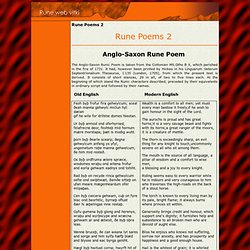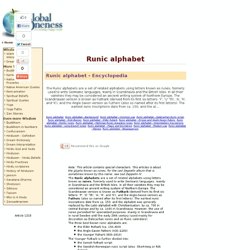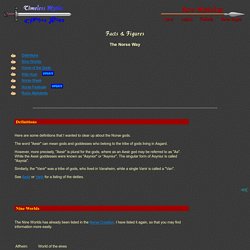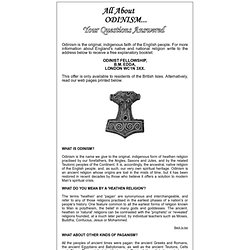

Runes, Alphabet of Mystery. Runepoem.swf (application/x-shockwave-flash Object) Rune Poems2. Feoh byþ frofur fira gehwylcum; sceal ðeah manna gehwylc miclun hyt dælan gif he wile for drihtne domes hleotan.

Ur byþ anmod ond oferhyrned, felafrecne deor, feohteþ mid hornum mære morstapa; þæt is modig wuht. þorn byþ ðearle scearp; ðegna gehwylcum anfeng ys yfyl, ungemetum reþe manna gehwelcum, ðe him mid resteð. Os byþ ordfruma ælere spræce, wisdomes wraþu ond witena frofur and eorla gehwam eadnys ond tohiht. Rad byþ on recyde rinca gehwylcum sefte ond swiþhwæt, ðamðe sitteþ on ufan meare mægenheardum ofer milpaþas. Cen byþ cwicera gehwam, cuþ on fyre blac ond beorhtlic, byrneþ oftust ðær hi æþelingas inne restaþ. Gyfu gumena byþ gleng and herenys, wraþu and wyrþscype and wræcna gehwam ar and ætwist, ðe byþ oþra leas.
Wenne bruceþ, ðe can weana lyt sares and sorge and him sylfa hæfþ blæd and blysse and eac byrga geniht. Hægl byþ hwitust corna; hwyrft hit of heofones lyfte, wealcaþ hit windes scura; weorþeþ hit to wætere syððan. The horse is a joy to princes in the presence of warriors. Poe.pdf (application/pdf-objek) The Runes by Freya Aswynn. Runic alphabet: Encyclopedia - Runic alphabet. Note: This article contains special characters.

This articles is about the glyphs known as runes, for the Led Zeppelin album that is sometimes known by this name, see Led Zeppelin IV. The Runic alphabets are a set of related alphabets using letters known as runes , formerly used to write Germanic languages, mainly in Scandinavia and the British Isles. In all their varieties they may be considered an ancient writing system of Northern Europe. The Scandinavian version is known as Futhark (derived from its first six letters: 'F', 'U' 'Th', 'A', 'R', and 'K'), and the Anglo-Saxon version as Futhorc (also so named after its first letters).
The earliest runic inscriptions date from ca. 150, and the alphabet was generally replaced by the Latin alphabet with Christianisation, by ca. 700 in central Europe and by ca. 1400 in Scandinavia. The three best known runic alphabets are: the Elder Futhark (ca. 150–800) the Anglo-Saxon Futhorc (400–1100) the Younger Futhark (800–1910) Facts and Figures: The Norse Way. Runic alphabets provided a brief background about the mystical lettering systems used by the Germanic people in ancient and medieval times.

Variations of the Runes The runes were set of Germanic alphabets that were used by the North German tribes, from the 2nd century BC to the 13th century AD. The runic alphabets were often called "Futhark", which is derived from the first six runic letters of the runic alphabets (F-U-TH-A-R-K). There are three different variations of the Runic alphabets. The Etruscan or the Latin alphabets probably influenced the runic scripts in the 2nd or 1st century BC, particularly when that some of runes match the Latin alphabets in form. It was used in northern Europe, right up to the 8th century AD.
The Anglian or Anglo-Saxon scripts, also known as Futhork, varied in number, from 28 to 33 characters. There are two variations of the Anglo-Saxon scripts. There are two variations of the Nordic runes: Short-twig and Danish. Runic Attitude. Yggdrasil.jpg (JPEG Image, 504x750 pixels) The Odinist Fellowship. Odinism is the name we give to the original, indigenous form of heathen religion practised by our forefathers, the Angles, Saxons and Jutes, and by the related Teutonic peoples of the Continent.

It is, accordingly, the ancestral, native religion of the English people, and, as such, our very own spiritual heritage. Odinism is an ancient religion whose origins are lost in the mists of time, but it has been restored in recent decades by those who believe it offers a solution to modern Man's spiritual crisis. The terms 'heathen' and 'pagan' are synonymous and interchangeable, and refer to any of those religions practised in the earliest phases of a nation's or people's history. One feature common to all the earliest forms of religion known to Man is polytheism, the belief in many gods and goddesses. Back to top. Woden, Odin and the Runes. Home - Rune Healing: Mind, Body & Spirit.